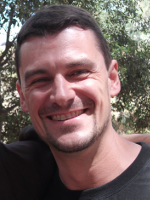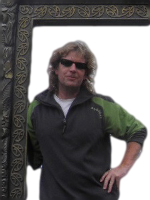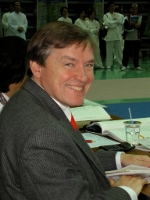| Date/Time | 10:00–13:00 Workshops: |
15:00–18:00 | 19:30–22:00 |
|---|---|---|---|
| Friday, 11. 9. 2015 | Practice in pairs | - | |
| Saturday, 12. 9. 2015 | Practice in pairs | Gala-evening | |
| Sunday, 13. 9. 2015 | Practice in pairs | - |
- Workshops – Experienced teachers will present their methods of work in Tai Chi Chuan and push hands.
- Practice in pairs – Participants will individually agree on how they want to practice in pairs. They will practice in 10-minute rounds. Participants will agree on the type of practice (free push hands vs. form push hands, with steps vs. without steps). The level is always adjusted to the practitioner with less experience.
- Gala-evening – Space for presentations of styles, schools and forms as well as a friendly meeting.
Teachers
Luciano Vida
Biography:  Luciano, Italian, lives in Spain from 2000. He started studying taijiquan for the first time in Kunming, China twice in ‘97 and ‘99, altogether for about 8 months. Then, back to Italy, met M. Chen Xiaowang and studied with him from 2000 to 2008, meanwhile he also studied with his nephew M. Chen Bing and with M. Jan Silberstorff. He went several times to Chenjiagou in summer time to deepen his knowledge. In 2007 he became member of the XX generation of the Chen family, disciple of M. Chen Xiaowang.
Luciano, Italian, lives in Spain from 2000. He started studying taijiquan for the first time in Kunming, China twice in ‘97 and ‘99, altogether for about 8 months. Then, back to Italy, met M. Chen Xiaowang and studied with him from 2000 to 2008, meanwhile he also studied with his nephew M. Chen Bing and with M. Jan Silberstorff. He went several times to Chenjiagou in summer time to deepen his knowledge. In 2007 he became member of the XX generation of the Chen family, disciple of M. Chen Xiaowang.
Notwithstanding that, after his meeting with Master Gianfranco Pace of the I.T.K.A. (International Taijiquan Kung Fu Association) he felt so much fulfilled with his way of understanding and transmitting Taijiquan that he decided quitting all he knew to re-start his practise under the guide of his new Master. Now he’s representing I.T.K.A. in Spain.
Topic:
- elastic peng jing and spiral force
- why fixed step and why moving step
- accepting step to a new strong condition
Links: Chen Taichi Vida
Radek Kolář
Topic: [Topic].
Links:
Roland von Loefen
Biography:  Roland started his Taijiquan — practice 1988 with Helmut Bauer, Barbara Schmid-Neuhaus and Toyo Kobayashi in the tradition of Cheng Man Ching. In 1998, Roland met master Yek Sing Ong and his current teacher Wee Kee Jin. Through long intensive training he eventually became a certified Instructor and Teacher of Wee Kee Jin’s “Taijiquan School of Central Equilibrium”. In 2013 he founded and organized the 1st international push hands meeting in Haßfurt am Main.
Roland started his Taijiquan — practice 1988 with Helmut Bauer, Barbara Schmid-Neuhaus and Toyo Kobayashi in the tradition of Cheng Man Ching. In 1998, Roland met master Yek Sing Ong and his current teacher Wee Kee Jin. Through long intensive training he eventually became a certified Instructor and Teacher of Wee Kee Jin’s “Taijiquan School of Central Equilibrium”. In 2013 he founded and organized the 1st international push hands meeting in Haßfurt am Main.
Topic: We want to work on yielding, pushing with a relaxed force. If you can yield, you have the ability to neutralize the opponents force. Our exercises are fix push hands and semi-free push hands. The advantage of Semi-free Pushing Hands is, that you can learn to listen and sense how your partner behaves. Winning is only secondary as you change roles after 5 minutes.
We are using 3 different stances for this kind of pushing hands.
Links:
Tomasz (Thomas) Nowakowski
 Biography: Tomasz (Thomas) Nowakowski living in London, visual and martial artist. He has studied different martial arts since 1966 and has been teaching T’ai Chi Ch’uan and Qi Gong since 1982. During last 30 years Thomas has taught Tai Chi Chuan and Qi Gong in many countries: Austria, Czech Republic, France, Germany, Italy, Poland, Slovakia, Taiwan and United Kingdom. He has lead workshops at his own school as well as for different companies, cultural and educational institutions. Thomas was a judge at Open National Championship of Taiwan in 2004. He is co-founder The Centre of Taoist Arts Golden Hill (Zlaty Kopec) in Prague, International Push Hands Meeting in Prague and founder Tai Chi Art Centre London. In 1990 he met his current teacher Dr Ming Wong C.Y. and has studied his family style Tai Chi, Tai Ki Kung San Fung and some techniques and theory of Chinese medicine. Thomas is the author of “Shapes of Balance” system (structured development of perception).
Biography: Tomasz (Thomas) Nowakowski living in London, visual and martial artist. He has studied different martial arts since 1966 and has been teaching T’ai Chi Ch’uan and Qi Gong since 1982. During last 30 years Thomas has taught Tai Chi Chuan and Qi Gong in many countries: Austria, Czech Republic, France, Germany, Italy, Poland, Slovakia, Taiwan and United Kingdom. He has lead workshops at his own school as well as for different companies, cultural and educational institutions. Thomas was a judge at Open National Championship of Taiwan in 2004. He is co-founder The Centre of Taoist Arts Golden Hill (Zlaty Kopec) in Prague, International Push Hands Meeting in Prague and founder Tai Chi Art Centre London. In 1990 he met his current teacher Dr Ming Wong C.Y. and has studied his family style Tai Chi, Tai Ki Kung San Fung and some techniques and theory of Chinese medicine. Thomas is the author of “Shapes of Balance” system (structured development of perception).
Topic:
The application of “Shapes of Balance” system (structured development of perception) into practice with partner.
We will be working with “Listening” (ting jin) and “Interpretation” (dong jin), feeling, conscious of:
- balance of structure
- mind intention
- timing
- emission 13 Basic Tai Chi forms of kinetic energy (internal force),
in different level tuishou and applications.
The workshop is open for beginners and advanced.
Links:
- Centre of Taoist Arts Golden Hill (home page)
- Tai Ki Kung
Miroslav Brožíček
Topic:
Introduction to Kyusho-Jutsu
Kyusho-Jutsu (abbreviated Kyusho) are vital points (also known as pressure points) on the human body. Kyusho is not in itself a martial art, but rather a way to manipulate, use and know these vital points. Knowledge of these vital points can be applied in the martial arts, massage, therapy, intimate parts of life, in police and special forces, etc. These findings about the human response to various points on the body are based on knowledge of Chinese medicine.
For combat form of Kyusho-Jutsu, there are many names (eg. Dim-mak, Dim Hsueh, Kupso Sul, Marma Adi, etc.).
Links:
- Kyusho Prague (school page, Czech)
- Video from Czech TV
- Pressure point — info from Wikipedia

